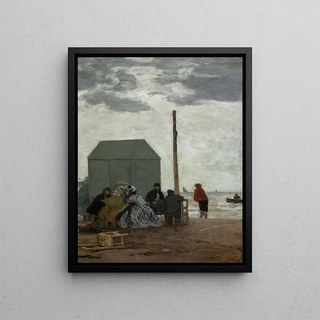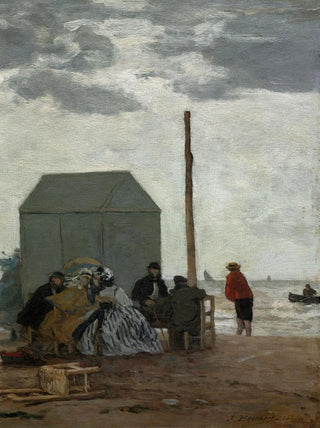Painting La plage de Deauville - Eugène Boudin | Art print


View from behind

Frame (optional)
Deauville Beach - Eugène Boudin – Engaging Introduction
Deauville Beach, an iconic work by Eugène Boudin, transports viewers to a moment suspended at the edge of the sea. In this scene, light plays a crucial role, illuminating the faces of bathers and the sails of boats anchored on the horizon. Boudin, a pioneer of Impressionism, captures with unmatched delicacy the lively and ever-changing atmosphere of the Normandy coast. This painting not only evokes the beauty of the landscape but also the carefree spirit of an era when the beach was a place of gathering and entertainment. Contemplating this work invites one to immerse themselves in the seaside universe of the 19th century, where nature and man coexisted in perfect harmony.
Style and uniqueness of the work
Boudin's style is distinguished by his mastery of light and color. In Deauville Beach, the shades of blue in the sky blend with the golden tones of the sand, creating a vibrant and lively tableau. The artist employs fluid and dynamic brushstrokes that give an impression of movement, as if the wind itself animates the scene. The human figures, although secondary in the composition, add a human dimension to this natural landscape. The way Boudin depicts shadows and reflections on the water demonstrates his meticulous observation and his ability to render reality tangible. This work is a perfect example of his unique approach, combining realism and Impressionism, and reflecting his love for nature and everyday life.
The artist and his influence
Eugène Boudin, often considered the father of Impressionism, had a major influence on artists such as Claude Monet and Pierre-Auguste Renoir. Born in 1824 in Honfleur, he developed a passion for maritime landscapes at an early age, a theme that would become his signature. His innovative technique, focused on direct observation of nature, paved the way for a new way of seeing the world. Boudin was able to capture not only the beauty of landscapes but also the human emotions associated with them. His work contributed to the evolution of modern art, inspiring artists to

Matte finish

View from behind

Frame (optional)
Deauville Beach - Eugène Boudin – Engaging Introduction
Deauville Beach, an iconic work by Eugène Boudin, transports viewers to a moment suspended at the edge of the sea. In this scene, light plays a crucial role, illuminating the faces of bathers and the sails of boats anchored on the horizon. Boudin, a pioneer of Impressionism, captures with unmatched delicacy the lively and ever-changing atmosphere of the Normandy coast. This painting not only evokes the beauty of the landscape but also the carefree spirit of an era when the beach was a place of gathering and entertainment. Contemplating this work invites one to immerse themselves in the seaside universe of the 19th century, where nature and man coexisted in perfect harmony.
Style and uniqueness of the work
Boudin's style is distinguished by his mastery of light and color. In Deauville Beach, the shades of blue in the sky blend with the golden tones of the sand, creating a vibrant and lively tableau. The artist employs fluid and dynamic brushstrokes that give an impression of movement, as if the wind itself animates the scene. The human figures, although secondary in the composition, add a human dimension to this natural landscape. The way Boudin depicts shadows and reflections on the water demonstrates his meticulous observation and his ability to render reality tangible. This work is a perfect example of his unique approach, combining realism and Impressionism, and reflecting his love for nature and everyday life.
The artist and his influence
Eugène Boudin, often considered the father of Impressionism, had a major influence on artists such as Claude Monet and Pierre-Auguste Renoir. Born in 1824 in Honfleur, he developed a passion for maritime landscapes at an early age, a theme that would become his signature. His innovative technique, focused on direct observation of nature, paved the way for a new way of seeing the world. Boudin was able to capture not only the beauty of landscapes but also the human emotions associated with them. His work contributed to the evolution of modern art, inspiring artists to
12,34 €






